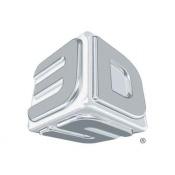
Kevin McAlea, EVP, General Manager, Metals and Healthcare, 3D Systems, said, “The addition of VSP Cranial affords surgeons the ability to visualize and pre-plan complex cranial reconstructive surgeries that may not have been possible previously. 3D Systems is committed to expanding our solutions to support the most advanced patient care available.”
The VSP service, under the direction of the doctor presiding over each specific case, combines surgical simulation, medical image processing, and 3D printing in order to provide patient-specific surgical plans. Engineers with 3D Systems use patient CT scans to transform 3D anatomical data into 3D images, which let the surgeon visualize the medical procedure. The company’s engineers help the surgical team, via an online meeting, create a virtual plan for the upcoming surgery. Once the plan is fully fleshed out, 3D Systems’ SLA printers will create whatever patient-specific tools are needed, including anatomical models and marking and positioning guides. These tools are 3D printed in white and clear materials, with options to use color to distinguish structures such as blood vessels and nerves.
Dr. James Goodrich holds the 3D printed model of Jadon and Anias McDonald’s conjoined skulls [Photo: CNN]
Dr. Oren Tepper, Director of Aesthetic Surgery, Montefiore Health System and Assistant Professor of Plastic Surgery, Albert Einstein College of Medicine, said, “As someone who has routinely used VSP for over five years, I have quickly adopted cranial applications into my practice. Fortunately, my neurosurgery colleagues also recognize the clinical value of VSP Cranial, and this technology now plays an integral role in many of our combined intracranial cases. 3D Systems’ engineers make the process seamless, especially for physicians who may be less familiar with these applications.”
During her visit to 3D Systems’ Colorado Healthcare Technology Center, Goehrke had a chance to test out some of the VSP equipment, including a haptic pen and the several simulators that were available, including the GI Mentor Express used for colonoscopies and the ANGIO Mentor for cardiac procedures. The tour also featured presentations of two case studies for which 3D Systems had created detailed cranial models, including the separation of twins Jadon and Anias McDonald, twin boys who were born conjoined at the brain. Two of the company’s higher-ups were actually in the OR during the last surgery that ultimately separated the twins.
If you’d like to learn more about VSP Cranial, and you happen to be in beautiful Hawaii next week, visit 3D Systems’ booth #2 at the American Society for Craniofacial Surgery (ASCFS) Symposium in Maui, January 23-25. You can watch a video demonstration of VSP Cranial below:
Discuss in the Virtual Surgical Planning forum at 3DPB.com.
[Source: 3D Systems]